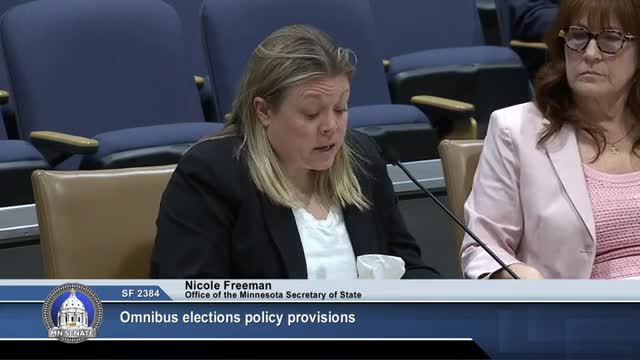Minnesota Senate revises election laws to streamline ballot corrections and voter access
April 04, 2025 | Elections, Senate, Committees, Legislative, Minnesota
This article was created by AI summarizing key points discussed. AI makes mistakes, so for full details and context, please refer to the video of the full meeting. Please report any errors so we can fix them. Report an error »

In a recent meeting of the Minnesota Senate's Committee on Elections, key discussions unfolded around proposed improvements to the state's election administration processes. The atmosphere was charged with a sense of urgency as committee members and local officials gathered to address pressing issues that could enhance the efficiency and accessibility of elections in Minnesota.
One of the standout proposals discussed was aimed at streamlining the resolution of ballot errors. Local administrators expressed optimism that the new measures would allow them to work directly with affected candidates to quickly correct any mistakes, thereby reducing the burden on county attorneys and district courts. This initiative is expected to save valuable time and resources, allowing legal professionals to focus on more pressing matters.
The committee also highlighted the importance of incentivizing candidates to reach sensible agreements regarding ballot issues. A proposed mechanism would require losing parties to pay court fees if their arguments are deemed unreasonable, encouraging collaboration and reducing unnecessary court cases that could delay election processes.
In addition to these measures, the committee reviewed enhancements to the election judge party lists, which will now be received earlier from political parties. This change aims to improve the assignment of election judges, ensuring that local administrators can effectively manage their roles in a timely manner.
Voter access and security were also focal points of the discussion. The formalization of chain of custody plans for ballots was praised as a significant step forward, empowering local election officials to better manage and secure the electoral process. Furthermore, the codification of the election night reporting system and the requirement for counties to conduct unofficial results report testing before elections were seen as vital improvements to ensure smoother election nights.
Another critical point raised was the requirement for mail ballots to be sent out at least 20 days prior to election day. This provision aims to accommodate potential delays in mail delivery, ensuring that voters have ample time to receive, review, and return their ballots.
As the meeting concluded, there was a palpable sense of collaboration among committee members and local officials. The discussions reflected a commitment to enhancing Minnesota's electoral processes, with a focus on efficiency, accessibility, and security. The proposed changes, if enacted, could significantly impact how elections are conducted in the state, fostering a more streamlined and voter-friendly environment.
One of the standout proposals discussed was aimed at streamlining the resolution of ballot errors. Local administrators expressed optimism that the new measures would allow them to work directly with affected candidates to quickly correct any mistakes, thereby reducing the burden on county attorneys and district courts. This initiative is expected to save valuable time and resources, allowing legal professionals to focus on more pressing matters.
The committee also highlighted the importance of incentivizing candidates to reach sensible agreements regarding ballot issues. A proposed mechanism would require losing parties to pay court fees if their arguments are deemed unreasonable, encouraging collaboration and reducing unnecessary court cases that could delay election processes.
In addition to these measures, the committee reviewed enhancements to the election judge party lists, which will now be received earlier from political parties. This change aims to improve the assignment of election judges, ensuring that local administrators can effectively manage their roles in a timely manner.
Voter access and security were also focal points of the discussion. The formalization of chain of custody plans for ballots was praised as a significant step forward, empowering local election officials to better manage and secure the electoral process. Furthermore, the codification of the election night reporting system and the requirement for counties to conduct unofficial results report testing before elections were seen as vital improvements to ensure smoother election nights.
Another critical point raised was the requirement for mail ballots to be sent out at least 20 days prior to election day. This provision aims to accommodate potential delays in mail delivery, ensuring that voters have ample time to receive, review, and return their ballots.
As the meeting concluded, there was a palpable sense of collaboration among committee members and local officials. The discussions reflected a commitment to enhancing Minnesota's electoral processes, with a focus on efficiency, accessibility, and security. The proposed changes, if enacted, could significantly impact how elections are conducted in the state, fostering a more streamlined and voter-friendly environment.
View full meeting
This article is based on a recent meeting—watch the full video and explore the complete transcript for deeper insights into the discussion.
View full meeting
